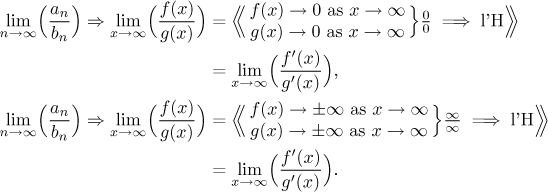Theorem (L'Hospital's rule).
Let f and g be functions defined on some
![]()
assuming that the limit on the right exists.
This topic is actually borrowed from the theory of functions. Therefore we just briefly restate the theorem in the form applicable to sequences:
Theorem (L'Hospital's rule).
Let f and g be functions defined on some(K,∞). If both f and g have limit at infinity equal to 0, or both f and g have infinite limit at infinity, then
assuming that the limit on the right exists.
How does it help? Imagine that we have two sequences,
![]() or
or
![]() .
If the formula that defines the sequence
.
If the formula that defines the sequence

In any of the two cases above, if the limit on the right exists, then the result is also valid for the limit on the left, consequently also for the ratio of the two sequences. On the other hand, if the procedure fails (for instance if the limit on the right does not exist), we cannot say anything about the sequence problem (see for instance this example in Solved Problems - Limits).
Note that usually we would use a shorter way to indicate the application of the l'Hospital rule, see the next example.
Example:

Since we got a definite answer at the end, the "conditional equality" in the l'Hospital rule step is justified.
The assumptions in the theorem as essential for its validity. If a limit is not of the specified type, l'Hospital's formula is no longer generally true. Consider the following very simple example:
Example:
![]()
Note that this limit problem was not of the l'Hospital type (zero over zero, infinity over infinity, not even something over infinity) and therefore l'Hospital's rule cannot be used. What happens if we forget to check type and get seduced by the ratio form of this problem to apply the l'Hospital rule? We get the wrong answer:

The l'Hospital theorem can be actually stated in more generality. The version that we quoted above is the one used in most calculus texts and courses. This is why we will usually (if possible) pretend while solving problems in Math Tutor that it is the only version we know, so that you won't run into trouble by getting used to something your prof did not cover.
What is the more general version? The case
![]() cannot be generalized, there
the theorem was the best possible. However, for the other case,
cannot be generalized, there
the theorem was the best possible. However, for the other case,
![]() , we actually
need not worry about the numerator; the l'Hospital rule applies to the type
"something over infinity"!
, we actually
need not worry about the numerator; the l'Hospital rule applies to the type
"something over infinity"!
Theorem (L'Hospital's rule).
Let f and g be functions defined on some(K,∞). If g tends to infinity as x goes to infinity, then
assuming that the limit on the right exists.
Does this more general version have any advantage? Consider the ratio
You can see that in most cases, the first version of l'Hospital is quite
sufficient. Is there any advantage to the new version then? Definitely.
First, you may encounter problems where the numerator does tend to infinity,
but proving it would be so much work that you would really appreciate knowing
that you can skip it and use the more general rule (you still have to prove
that the denumerator goes to infinity, but that's half the work compared to
the first version of l'Hospital). So the more general version is definitely
more convenient for the problems with infinity (it saves no work in "zero
over zero" cases).
But that is not all. It may happen that the numerator actually does not have
any limit! While the first version cannot be used for the type "DNE over
infinity", the more general one can! Therefore, although we promised to stick
to the first version whenever possible, we will also use the more general one
ocassionally.
For practical tips on l'Hospital's rule see the box "indeterminate ratio" in Methods Survey - Limit.
In Solved Problems - Limits, l'Hospital's rule is used in this problem (which is a typical textbook example), it is also a part of most other solutions, notably in this problem, this problem, this problem, and this problem. For a nice example where the l'Hospital rule can be applied, but leads to no conclusion, check out this problem.